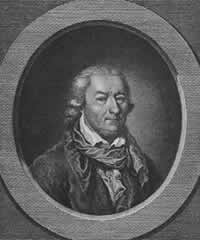Neuhofyears
1769-1798
The ideal of a farmer and the farmer Pestalozzi
Like the other members of the "Zurich Patriotenkreis" also Pestalozzi was enchanted by Rousseau's ideal of a natural, virtuous and free life. The life of people from the cities seemed to be distorted, spoiled and artificial. A farmer in contrast lived a simple life, powerful and in close contact with nature. This point of view was linked with the will to help the poor people on the countryside. So the 21-year old Pestalozzi considered his studies as early finished and decided to become a farmer. He started an apprenticeship at the farm of a classic example for a farmer from Bern: Johann Rudolf Tschiffeli Annotation. There he studied fruit-growing and agriculture, planting and nursing of little plants and herbs, conservation of vegetables and fruits and land improvement with fertilizers. Furthermore he learned all the necessary economical calculations and to deal with customers and salesmen. In short words: Pestalozzi learned the essential features of modern agriculture Annotation .
When Pestalozzi already in the age of 21 tried to get some practical and economically useful experience it was just partly because he was crazy about the simple farmer's life and his wish to help the rural population in being a good example. The second reason was furthermore that he fell in love with Anna Schulthess , wanted to marry her and therefore he wanted to be able to take care for a family. And for a citizen of the city of Zurich there were only two possibilities: Either he joined the civil service or he became entrepreneur. Pestalozzi knew that he had gambled away the first possibility in taking part in several rebellious actions of the "Zurich Patrioten". So he picked the second one and hoped to be successful as entrepreneur. Indeed Pestalozzi understood himself as entrepreneur all his life- he really felt like one.
In September 1767 Pestalozzi started his apprenticeship at Tschiffeli's farm in Kirchberg. It finally lasted not more than half a year. Several letters to Anna Schulthess witness that Pestalozzi understood his apprenticeship as a preparation for an occupation for the well-being of the people and that his agricultural enterprise should aim at "the happiness of many of his fellow creatures" (PSB 1, p. 241) He dreamed of his future actions in idyllic pictures. But as it will soon appear the charitable work should not be sweetened by pleasure but rather suffered by pain, renunciation and disappointment.
After his return from Kirchberg Pestalozzi bought 20 hectares land from more than 50 farmers. The land was situated 25 kilometres away from Zurich in Birr (where Pestalozzi is buried today) and was not very fertile meadow and arable land. There he built new houses outside the village. This "Neuhof" should be his home from thereon, although he lived in several other places later. He administered and lived on the estate until 1798 and returned in 1825 when he was forced to close his institute for education in Yverdon. During Pestalozzi's absence the Neuhof was administered by his only son who died in 1801 in the age of 31 years. Then the second husband of his widow took over and finally Pestalozzi's only grandson Gottlieb managed the estate. Today the Neuhof is an institute for education and a technical school for endangered youth.
Pestalozzi planned according to the physiocratism to meliorate the soil with new fertilizing-methods and to introduce the cultivation of the Esparsette- a new food plant- and the madder plant, which roots were used for the production of red pigment by textile industry. He was able to finance this project with the heritage of his father, with a loan from his uncle on his mother's side and also with an advance given by a Zurich bank, which belonged to distantly relatives of his wife.
Right from the beginning there were a lot of difficulties, which finally broke the neck of Pestalozzi's enterprise. In fact the disaster started when Pestalozzi gave himself into the hands of Heinrich Märki Annotation , the landlord and butcher of Birr. He was an unscrupulous and disreputable speculator who knew how to benefit from his business and from his clients. Pestalozzi had no father who was able to help him in founding an enterprise. His real father was dead for a long time and Anna's family, who was experienced in business matters let him down. But Pestalozzi was also not a man who wanted any advice when he had his plans. Furthermore also Ann had not learned to use their money sparingly and the relationship with their neighbours did finally absolutely not correspond to the ideal Annotation Pestalozzi described in his letter about his future life. But however life at Neuhof was not at all "unpronounceable charming" because his neighbours were full of suspicion and mistrust and put as much obstacles in his way as they could. They walked through his sensitive fields as they were used to do in the infertile meadows and put their livestock out to pasture on the fallow fields as they did before when there was the classical three-field rotation. They did not care at all about the fact that the madder plant needs 4 years to develop its roots, they just wanted their rights. Pestalozzi first tried to talk to them, and then he built fences, which were destroyed over and over again. So he had to take legal action to get his right. But by this he had gambled away the friendship of his neighbours. Furthermore the other farmers disreputed Pestalozzi towards his financial backer and even his own farm hand talked to the bank in Zurich about allegedly lack of success. So the bank declared the enterprise to be failed on 12th August 1770 and withdrew its money before Pestalozzi was able to bring in the crop the first time and before the carpenter was able to build the roof truss of the new house.
In fact the soil at the Neuhof estate was not very suitable for madder cultivation and the small amount that could have prospered was destroyed in the year 1771 and 1772. The crop failures in this year caused famine all over Europe. Pestalozzi tried to save his estate by stock breeding but for that he had absolutely no detailed knowledge. His debts became bigger and bigger and finally in 1774 the young farmer Pestalozzi was ruined. He sold his livestock; he leased large parts of his land to other farmers and nevertheless did not get rid of his debts. Finally the debts were paid by Anna's family with the success that Pestalozzi's brothers in law disliked him even more.

